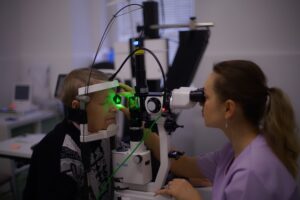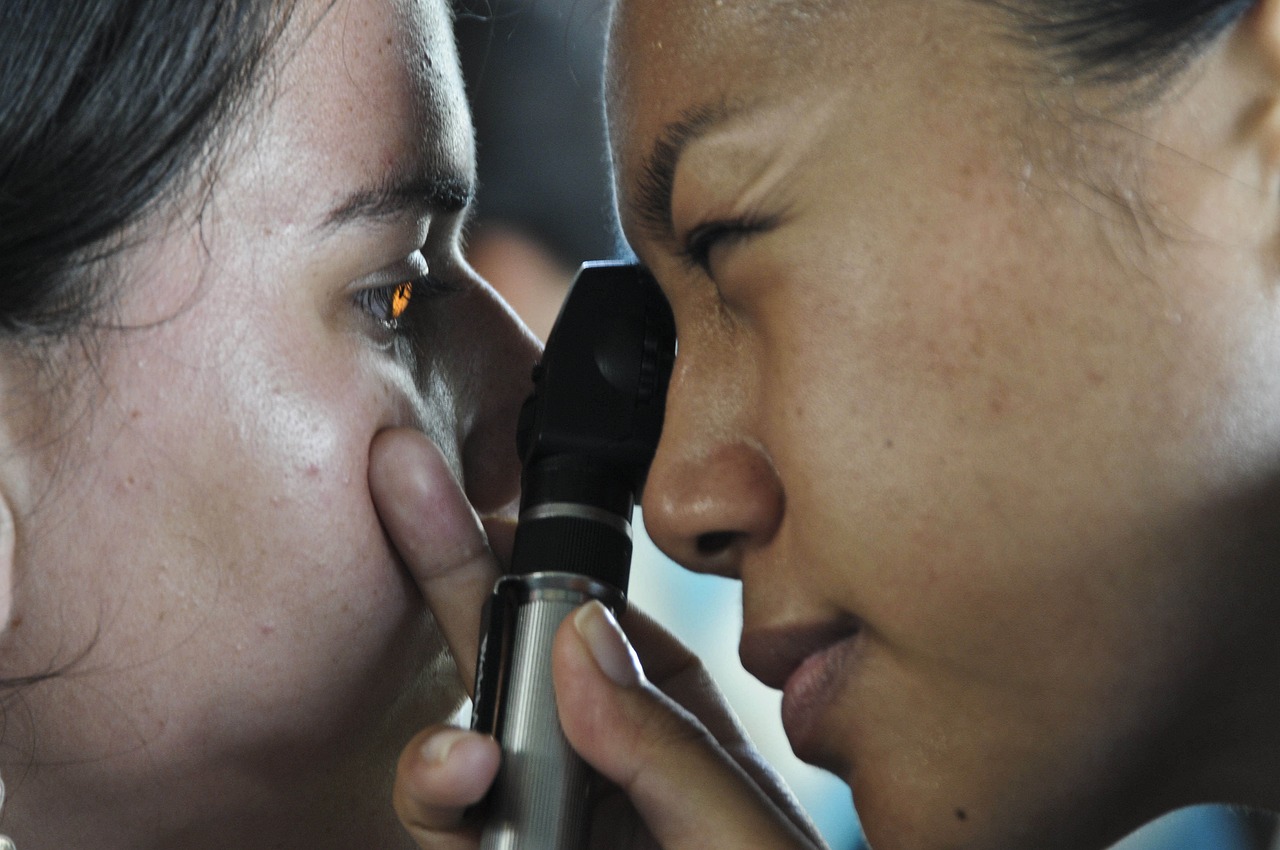Your eyes are windows to the world, but what happens when those windows aren’t perfectly clear? There are different kind of refractive errors, such as myopia, hyperopia, and astigmatism, which can lead to more than just blurry vision. They may also increase your risk for serious retinal issues. Understanding these potential complications is crucial for anyone navigating life with refractive errors. Let’s delve into the eye health concerns that could arise and how they might affect your overall vision in the long term.
Increased Risk of Retinal Detachment
 Refractive errors, especially myopia, can elevate the risk of retinal detachment. When the eye elongates due to myopia, it stretches the retina. This stretching weakens its structure and makes it more vulnerable. Retinal detachment occurs when the thin layer at the back of your eye separates from its underlying support tissue. Symptoms may include sudden flashes of light or a shower of floaters in your vision. If left untreated, retinal detachment can lead to permanent vision loss.
Refractive errors, especially myopia, can elevate the risk of retinal detachment. When the eye elongates due to myopia, it stretches the retina. This stretching weakens its structure and makes it more vulnerable. Retinal detachment occurs when the thin layer at the back of your eye separates from its underlying support tissue. Symptoms may include sudden flashes of light or a shower of floaters in your vision. If left untreated, retinal detachment can lead to permanent vision loss.
Myopic Maculopathy
Myopic maculopathy is a serious condition that arises from high levels of myopia, or nearsightedness. It primarily affects the macula, the central part of the retina responsible for sharp vision. As individuals with myopia age, changes in their retina can lead to significant visual impairment. This condition occurs when elongated eyeballs cause stretching and thinning of the retinal tissue. The result is often a distorted or blurred central vision. Many people may not notice symptoms until the damage has progressed significantly. Patients might experience challenges with reading or recognizing faces clearly.
Retinal Tears
Retinal tears can emerge as a concerning complication of refractive errors. These tears occur when the retina, the thin layer of tissue at the back of your eye, experiences stress or tension. Individuals with high levels of myopia are particularly susceptible to these issues. The elongated shape of their eyes increases strain on the retina, making it more vulnerable to tearing. Symptoms often include sudden flashes of light or an increase in floaters—those pesky little spots that drift across your vision. If you notice these signs, seeking prompt medical attention is crucial.
Retinal Vascular Changes
 Refractive errors can lead to significant retinal vascular changes. When the eye’s shape alters, it affects blood flow within the retina. This disruption can cause various complications. One prominent issue is the development of new blood vessels. These abnormal vessels often arise in response to reduced oxygen levels in the retina, a condition known as hypoxia. As they grow, they may leak fluid or bleed, leading to vision impairment. Another concern involves thickening of existing blood vessel walls.
Refractive errors can lead to significant retinal vascular changes. When the eye’s shape alters, it affects blood flow within the retina. This disruption can cause various complications. One prominent issue is the development of new blood vessels. These abnormal vessels often arise in response to reduced oxygen levels in the retina, a condition known as hypoxia. As they grow, they may leak fluid or bleed, leading to vision impairment. Another concern involves thickening of existing blood vessel walls.
This change can hinder proper circulation and potentially lead to ischemia—an insufficient supply of blood that deprives tissues of necessary nutrients. Understanding the connection between refractive errors and retinal issues is essential for maintaining eye health. The increased risk of complications like retinal detachment, myopic maculopathy, and retinal tears highlights the importance of regular eye exams. Additionally, recognizing vascular changes can lead to early intervention. If you have refractive errors, staying vigilant about your vision is crucial. Routine check-ups with an eye care professional can help identify any potential problems before they escalate. Taking proactive steps towards managing your eye health will pay off in the long run. Remember that awareness and education are key components in preserving not just clarity of sight but overall quality of life. Prioritize your vision; it’s worth every effort.



 One of the gravest dangers of buying medicines online is the risk of receiving counterfeit or substandard products. Illicit online pharmacies may sell fake, expired, or contaminated medications. These counterfeit drugs may not contain the active ingredients necessary for proper treatment or, worse, contain harmful substances that can jeopardize your health. Without proper regulation and oversight, the online marketplace becomes a breeding ground for fraudulent sellers preying on unsuspecting customers.
One of the gravest dangers of buying medicines online is the risk of receiving counterfeit or substandard products. Illicit online pharmacies may sell fake, expired, or contaminated medications. These counterfeit drugs may not contain the active ingredients necessary for proper treatment or, worse, contain harmful substances that can jeopardize your health. Without proper regulation and oversight, the online marketplace becomes a breeding ground for fraudulent sellers preying on unsuspecting customers. When purchasing medications online, assessing potential drug interactions or identifying allergies becomes challenging. Professional pharmacists are trained to identify possible medication interactions and evaluate their compatibility with an individual’s medical history. Without their guidance, there is an increased risk of adverse reactions, harmful drug combinations, or worsening of pre-existing conditions. Proper medical supervision is crucial in minimizing such risks.
When purchasing medications online, assessing potential drug interactions or identifying allergies becomes challenging. Professional pharmacists are trained to identify possible medication interactions and evaluate their compatibility with an individual’s medical history. Without their guidance, there is an increased risk of adverse reactions, harmful drug combinations, or worsening of pre-existing conditions. Proper medical supervision is crucial in minimizing such risks.
 The first health benefit of using an air purifier is that it can help to lower your blood pressure. A study conducted in 2012 found that people who used an air purifier for two weeks significantly decreased their blood pressure.
The first health benefit of using an air purifier is that it can help to lower your blood pressure. A study conducted in 2012 found that people who used an air purifier for two weeks significantly decreased their blood pressure. The third health benefit of using an air purifier is that it can help to improve your sleep quality. A study conducted in 2015 found that people who used an air purifier for two weeks significantly improved their sleep quality.
The third health benefit of using an air purifier is that it can help to improve your sleep quality. A study conducted in 2015 found that people who used an air purifier for two weeks significantly improved their sleep quality.
 One of the best ways to ease anxiety before surgery is to be as prepared as possible. This means having all of your post-surgery supplies ready to go. This way, you won’t have to worry about scrambling to get everything together after your surgery.
One of the best ways to ease anxiety before surgery is to be as prepared as possible. This means having all of your post-surgery supplies ready to go. This way, you won’t have to worry about scrambling to get everything together after your surgery. Another way to ease anxiety before surgery is to keep yourself distracted. It can be anything from reading a book to watching your favorite TV show.
Another way to ease anxiety before surgery is to keep yourself distracted. It can be anything from reading a book to watching your favorite TV show. Last but not least, it’s essential to talk to your doctor about your anxiety and get all the information you need for the surgery. Your doctor can help ease your stress by answering any questions about the procedure. They can also provide you with information on what to expect before, during, and after surgery. Gathering all the information you need for your surgery will help you feel more prepared and less anxious.
Last but not least, it’s essential to talk to your doctor about your anxiety and get all the information you need for the surgery. Your doctor can help ease your stress by answering any questions about the procedure. They can also provide you with information on what to expect before, during, and after surgery. Gathering all the information you need for your surgery will help you feel more prepared and less anxious.
 Like many other people, you may be surprised that the lack of enough sleep may lead to low testosterone levels. Various research has shown that men who don’t get enough sleep tend to have lower testosterone levels than those who do.
Like many other people, you may be surprised that the lack of enough sleep may lead to low testosterone levels. Various research has shown that men who don’t get enough sleep tend to have lower testosterone levels than those who do. It is common knowledge that
It is common knowledge that 
 Your brain is tired! To awaken your brain’s quirkiness and humor, it probably helps to shake up your routine a bit. Make changes that challenge your current abilities. Instead of brushing with one hand, try brushing with the other. It is the same as a student sitting in a classroom staring at the teacher, not engaging with the courses and activities.
Your brain is tired! To awaken your brain’s quirkiness and humor, it probably helps to shake up your routine a bit. Make changes that challenge your current abilities. Instead of brushing with one hand, try brushing with the other. It is the same as a student sitting in a classroom staring at the teacher, not engaging with the courses and activities.  The more you know, the more areas you can cover. Have you tried reading several books on the same topic or genre? Chances are you are bent on predicting the flow of the reading or simply what the author will say. Reading is beneficial, but sometimes it can be tedious, especially if it doesn’t tickle the brain’s attention. When exposed to only one type of material, the mind is not stimulated at all.
The more you know, the more areas you can cover. Have you tried reading several books on the same topic or genre? Chances are you are bent on predicting the flow of the reading or simply what the author will say. Reading is beneficial, but sometimes it can be tedious, especially if it doesn’t tickle the brain’s attention. When exposed to only one type of material, the mind is not stimulated at all. 


 Exercise helps release accumulated toxins. Exercise helps discharge waste products that are often stored as fat in the tissues of the epidermis. An exercise routine of half an hour a day is an excellent way to detoxify the body.
Exercise helps release accumulated toxins. Exercise helps discharge waste products that are often stored as fat in the tissues of the epidermis. An exercise routine of half an hour a day is an excellent way to detoxify the body. Include fresh salads and smoothies to make exciting choices in your meals. Fruits and vegetables are low in carbs and full of fiber and water. Take inspiration from this fruit pair, and it won’t be that hard. If you are hesitant to go on a diet program, eating fresh is also a suitable way to detox your body.
Include fresh salads and smoothies to make exciting choices in your meals. Fruits and vegetables are low in carbs and full of fiber and water. Take inspiration from this fruit pair, and it won’t be that hard. If you are hesitant to go on a diet program, eating fresh is also a suitable way to detox your body.
 Calories aren’t the only thing that matters when it comes to weight loss. You should eat some higher calories foods, like nuts, seeds, and avocados. However, if you take in more calories than you burn, your system will continue to store those calories as fat. It doesn’t mean you need to obsess over calories, but do pay attention to them, especially in packaged foods.
Calories aren’t the only thing that matters when it comes to weight loss. You should eat some higher calories foods, like nuts, seeds, and avocados. However, if you take in more calories than you burn, your system will continue to store those calories as fat. It doesn’t mean you need to obsess over calories, but do pay attention to them, especially in packaged foods. If you’re switching to a plant-based diet, make sure you focus on consuming amounts of fruits and vegetables. Whether you’re plant-based or omnivorous, fill your plate at meals with veggies. Not only do fruits and vegetables have calories than other foods, but they’re also high in fiber, which contributes to overall satiety.
If you’re switching to a plant-based diet, make sure you focus on consuming amounts of fruits and vegetables. Whether you’re plant-based or omnivorous, fill your plate at meals with veggies. Not only do fruits and vegetables have calories than other foods, but they’re also high in fiber, which contributes to overall satiety.

 Being able to contribute to healthcare communities not only has advantages for you personally, like first-class support or personal relationships with your meals, but it also helps the community. You can help yourself to improve by investing your time, energy, and money. It is especially true if you have signs of fatigue: exhaustion, poor performance, illness, or decreased creativity. Studies show a neural connection between generosity and joy. But random acts of kindness in the neighborhood may not be possible given the current situation. With neighborhood facilities now closed, there is a real lack of opportunity to return. Therefore, people could have a place to rely on while encountering difficulties.
Being able to contribute to healthcare communities not only has advantages for you personally, like first-class support or personal relationships with your meals, but it also helps the community. You can help yourself to improve by investing your time, energy, and money. It is especially true if you have signs of fatigue: exhaustion, poor performance, illness, or decreased creativity. Studies show a neural connection between generosity and joy. But random acts of kindness in the neighborhood may not be possible given the current situation. With neighborhood facilities now closed, there is a real lack of opportunity to return. Therefore, people could have a place to rely on while encountering difficulties.


 Although you can switch cinnamon with other spices as the ingredient, cinnamon is the ideal spice to use. This is because it is rich in several nutrients and provides many health benefits to the entire body. Cinnamon is highly valued for its powerful antimicrobial, anti-inflammatory, and anti-infective properties. Cinnamon remains a natural remedy used as a powerful cure for insomnia and stomach problems, especially diabetes and snoring. Along with this, cinnamon is one of the many harms and discomforts as it contains anti-inflammatory properties. Since cinnamon is rich in fiber, it will help alleviate irritable bowel syndrome symptoms, for example, constipation and nausea.
Although you can switch cinnamon with other spices as the ingredient, cinnamon is the ideal spice to use. This is because it is rich in several nutrients and provides many health benefits to the entire body. Cinnamon is highly valued for its powerful antimicrobial, anti-inflammatory, and anti-infective properties. Cinnamon remains a natural remedy used as a powerful cure for insomnia and stomach problems, especially diabetes and snoring. Along with this, cinnamon is one of the many harms and discomforts as it contains anti-inflammatory properties. Since cinnamon is rich in fiber, it will help alleviate irritable bowel syndrome symptoms, for example, constipation and nausea.

 Simulation centers are nearly ubiquitous in nursing and medical schools. Many health care programs now incorporate simulation to enhance face-to-face clinical experiences and educational content. Over the past two decades, simulation has gained support in excellent health care programs because its effectiveness is supported by research and offers various educational benefits. Some licensure preparation programs, such as nursing, with the support of accrediting agencies and state licensing boards, have begun using simulation as a substitute for in-house clinical hours after a recent landmark study in several locations provided evidence. This evidence is considered an excellent simulation that can replace up to 50% of clinical hours while achieving similar educational outcomes.
Simulation centers are nearly ubiquitous in nursing and medical schools. Many health care programs now incorporate simulation to enhance face-to-face clinical experiences and educational content. Over the past two decades, simulation has gained support in excellent health care programs because its effectiveness is supported by research and offers various educational benefits. Some licensure preparation programs, such as nursing, with the support of accrediting agencies and state licensing boards, have begun using simulation as a substitute for in-house clinical hours after a recent landmark study in several locations provided evidence. This evidence is considered an excellent simulation that can replace up to 50% of clinical hours while achieving similar educational outcomes.
 Grooming your horse is especially important in the summer because it removes sweat from your horse’s skin and also helps prevent disease. By brushing your horse or pony, you remove old sand, skin, and hair and reduce the chance of your animal developing health problems and skin conditions such as thrush. The dressing also provides an opportunity to look closely at the animal’s body and look for abnormalities.
Grooming your horse is especially important in the summer because it removes sweat from your horse’s skin and also helps prevent disease. By brushing your horse or pony, you remove old sand, skin, and hair and reduce the chance of your animal developing health problems and skin conditions such as thrush. The dressing also provides an opportunity to look closely at the animal’s body and look for abnormalities.

 When cooking or frying with a toaster, we use butter or oil to keep the food moist while it is exposed to heat. This not only indicates that you are reducing the number of calories in this dish, but it also means that you are putting less unhealthy things throughout your body. Too much oil affects our health; that is who are health conscious prefer grilled foods.
When cooking or frying with a toaster, we use butter or oil to keep the food moist while it is exposed to heat. This not only indicates that you are reducing the number of calories in this dish, but it also means that you are putting less unhealthy things throughout your body. Too much oil affects our health; that is who are health conscious prefer grilled foods. Consider cooking a greasy piece of meat – just one on the grill and in the pan. When grilling, the excess fat melts on the grill, but the fat has nowhere to go and can eventually be absorbed back into the meat when cooking in a bowl. Excess fats that have melted in the grill are the ones that cause flames during cooking. It is clear to everyone that the sun and the atmosphere have many advantages for your system.
Consider cooking a greasy piece of meat – just one on the grill and in the pan. When grilling, the excess fat melts on the grill, but the fat has nowhere to go and can eventually be absorbed back into the meat when cooking in a bowl. Excess fats that have melted in the grill are the ones that cause flames during cooking. It is clear to everyone that the sun and the atmosphere have many advantages for your system.
 There are handfuls and many focused energy practice meetings accessible on the web to help keep you fit during exercises. Exercise shouldn’t be real; it very well might be as clear as going for a walk around the local park. The fundamental center is to keep on protecting examples, reasonable, and feasible. The upsides of remaining sound working Anywhere reach out past the group. An ongoing examination from the Harvard T.H. Chan School of Public Health found that doing 15 minutes consistently or strolling for one hour diminishes the likelihood of misery by 26 percent. Pioneers additionally advantage from the higher joy and efficiency of laborers in excellent physical and mental health.
There are handfuls and many focused energy practice meetings accessible on the web to help keep you fit during exercises. Exercise shouldn’t be real; it very well might be as clear as going for a walk around the local park. The fundamental center is to keep on protecting examples, reasonable, and feasible. The upsides of remaining sound working Anywhere reach out past the group. An ongoing examination from the Harvard T.H. Chan School of Public Health found that doing 15 minutes consistently or strolling for one hour diminishes the likelihood of misery by 26 percent. Pioneers additionally advantage from the higher joy and efficiency of laborers in excellent physical and mental health. Without entering the numerous minuscule nourishments versus breakfast/lunch/supper’ conversation, it is fundamental to keep a healthy eating routine when working from house. Our everyday diet assumes a significant function in our physical and mental wellbeing. Keep food unique about your workspace to prevent nibbling during the day. This implies allocating pre-assigned events for nourishments and staying with them—similar holds for remaining hydrated. Keep a container of water from your workspace in any capacity and review to top this up as the day progressed. Group pioneers can not direct what their staff burn-through. Also, it is in both the consideration of the individual and the independent company. Indeed, research from the British Journal of Health Psychology found that individuals who eat five servings of soil products four days for each.
Without entering the numerous minuscule nourishments versus breakfast/lunch/supper’ conversation, it is fundamental to keep a healthy eating routine when working from house. Our everyday diet assumes a significant function in our physical and mental wellbeing. Keep food unique about your workspace to prevent nibbling during the day. This implies allocating pre-assigned events for nourishments and staying with them—similar holds for remaining hydrated. Keep a container of water from your workspace in any capacity and review to top this up as the day progressed. Group pioneers can not direct what their staff burn-through. Also, it is in both the consideration of the individual and the independent company. Indeed, research from the British Journal of Health Psychology found that individuals who eat five servings of soil products four days for each. Presently the time has come to guarantee that your workspace is secure. That generally implies eliminating trip perils, ensuring that your working environment is sufficiently bright, and confirming all gadgets are controlled. Security isn’t limited to shielding yourself from immediate dangers. Also, it is essential to ensure your workspace and stuff are ergonomic. It might have all the earmarks of being a minor inconvenience now, yet it may turn into a drawn-out health problem whenever left unattended. For group pioneers, it was ensuring that your staff’s security when they work Everywhere boils down to a specific something: tutoring. Building up the best techniques for secure workspaces advances trust and makes a more loosened upsetting. At that point, this empowers individuals to focus on working to the absolute best of their abilities. This additionally cuts the likelihood of real injury or impairment, which means less time.
Presently the time has come to guarantee that your workspace is secure. That generally implies eliminating trip perils, ensuring that your working environment is sufficiently bright, and confirming all gadgets are controlled. Security isn’t limited to shielding yourself from immediate dangers. Also, it is essential to ensure your workspace and stuff are ergonomic. It might have all the earmarks of being a minor inconvenience now, yet it may turn into a drawn-out health problem whenever left unattended. For group pioneers, it was ensuring that your staff’s security when they work Everywhere boils down to a specific something: tutoring. Building up the best techniques for secure workspaces advances trust and makes a more loosened upsetting. At that point, this empowers individuals to focus on working to the absolute best of their abilities. This additionally cuts the likelihood of real injury or impairment, which means less time.

 Obviously, we are afraid of these “gas fart” noises that always come unexpectedly from colostomy bags. But you have to go out and meet friends or acquaintances. You can still dress well by wearing a dress a little loose around the waist.
Obviously, we are afraid of these “gas fart” noises that always come unexpectedly from colostomy bags. But you have to go out and meet friends or acquaintances. You can still dress well by wearing a dress a little loose around the waist.
 The chemical can prevent insecurities, irritation,
The chemical can prevent insecurities, irritation,  While the benefits could be tempting, CBD customers must understand that people have a lot of results worth understanding about first. Interestingly, animals do not endure similar outcomes. The most important disadvantage they might experience is minor sluggishness. Individuals who muster behind the usage of CBD for creatures are pushing to apart the artificial’s tastes with their pets.
While the benefits could be tempting, CBD customers must understand that people have a lot of results worth understanding about first. Interestingly, animals do not endure similar outcomes. The most important disadvantage they might experience is minor sluggishness. Individuals who muster behind the usage of CBD for creatures are pushing to apart the artificial’s tastes with their pets.
 Not all dieticians are the best for every customer. Before you buy a consultation, email the dietician or call her and ask her questions about whether she is the right person for you. Find out if they promote a healthy image that matches your goals. Look for articles written by the professional to see if you agree with her statements and if you respect her point of view.
Not all dieticians are the best for every customer. Before you buy a consultation, email the dietician or call her and ask her questions about whether she is the right person for you. Find out if they promote a healthy image that matches your goals. Look for articles written by the professional to see if you agree with her statements and if you respect her point of view.


 While many women usually want to undergo an operation to get an instant result as possible but they must consider the negative side of the breast surgery, including health risks, high costs, and an implant’s unnatural feeling. Considering these risks, many women prefer to find organic alternatives to breast augmentation. Are breast enhancement pills effective? The treatment is usually yes.
While many women usually want to undergo an operation to get an instant result as possible but they must consider the negative side of the breast surgery, including health risks, high costs, and an implant’s unnatural feeling. Considering these risks, many women prefer to find organic alternatives to breast augmentation. Are breast enhancement pills effective? The treatment is usually yes. More caution should be taken before buying a breast enlargement supplement for girls. When women take these pills, they should be aware of certain things that can harm their health and well-being. Women must follow the company’s instructions to the letter. Many women are advised to stick to a prescribed diet, as some products do not work well if women consume excessive amounts of protein or carbohydrates, for example.
More caution should be taken before buying a breast enlargement supplement for girls. When women take these pills, they should be aware of certain things that can harm their health and well-being. Women must follow the company’s instructions to the letter. Many women are advised to stick to a prescribed diet, as some products do not work well if women consume excessive amounts of protein or carbohydrates, for example.



 In reality, working from home may help you pursue a workout plan that you would have time for. There are dozens of workout sessions available to help keep you fit during workouts. Exercise does not need to be high intensity; it may be as straightforward as taking a stroll around the neighborhood park.
In reality, working from home may help you pursue a workout plan that you would have time for. There are dozens of workout sessions available to help keep you fit during workouts. Exercise does not need to be high intensity; it may be as straightforward as taking a stroll around the neighborhood park. That usually means making sure that your workplace is well-lit and removing hazards. Security is not restricted to protecting yourself from an immediate threat. Additionally, it is important to make sure your workspace and gear are ergonomic. Is your personal computer in an elevation that is comfortable?
That usually means making sure that your workplace is well-lit and removing hazards. Security is not restricted to protecting yourself from an immediate threat. Additionally, it is important to make sure your workspace and gear are ergonomic. Is your personal computer in an elevation that is comfortable?



 This is another great one. Don’t miss the warning that you are eating erratically or almost. If you don’t eat, there might be something there. Is the anxiety or depression getting worse? Could it be the side effects? Or could it be something else? It’s just another symptom we can quickly resolve.
This is another great one. Don’t miss the warning that you are eating erratically or almost. If you don’t eat, there might be something there. Is the anxiety or depression getting worse? Could it be the side effects? Or could it be something else? It’s just another symptom we can quickly resolve.
 Maintaining a good GPA through graduation is the most significant source of stress for college students. Grades can impact scholarships, job offers, class ranking, and graduate school eligibility. If scholarships are removed from some students, they may be asked to skip school for some time—this pressure students on exams and term papers on their undergraduate programs.
Maintaining a good GPA through graduation is the most significant source of stress for college students. Grades can impact scholarships, job offers, class ranking, and graduate school eligibility. If scholarships are removed from some students, they may be asked to skip school for some time—this pressure students on exams and term papers on their undergraduate programs.

 Focus on the components if you’re trying to heal wrinkles. Vitamin C must be present in the serum. It is because that’s what gives your skin back its youth. Vitamin C is an essential ingredient that helps promote the development of collagen. Collagen can help keep the skin from wrinkles and sagging and helps the skin feel soft.
Focus on the components if you’re trying to heal wrinkles. Vitamin C must be present in the serum. It is because that’s what gives your skin back its youth. Vitamin C is an essential ingredient that helps promote the development of collagen. Collagen can help keep the skin from wrinkles and sagging and helps the skin feel soft.
 Taking care of your health should be your priority, and that includes oral health. This is very important to maintain your well-being. Research has shown that the health of a person’s mouth and teeth is related to their health. The ability to chew your food is essential to your health. Poor oral health may cause low self-esteem and influence a person’s speech. In addition, a lot of doctors believe that a person’s oral health can be related to several diseases such as kidney and heart complications and diabetes. Oral care is important to ensure an excellent sense of health and well-being.
Taking care of your health should be your priority, and that includes oral health. This is very important to maintain your well-being. Research has shown that the health of a person’s mouth and teeth is related to their health. The ability to chew your food is essential to your health. Poor oral health may cause low self-esteem and influence a person’s speech. In addition, a lot of doctors believe that a person’s oral health can be related to several diseases such as kidney and heart complications and diabetes. Oral care is important to ensure an excellent sense of health and well-being.

 your kids follow a
your kids follow a